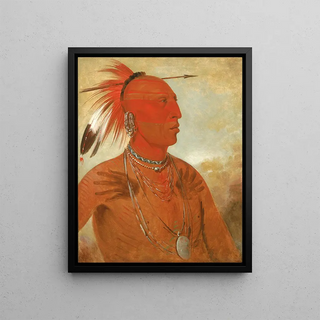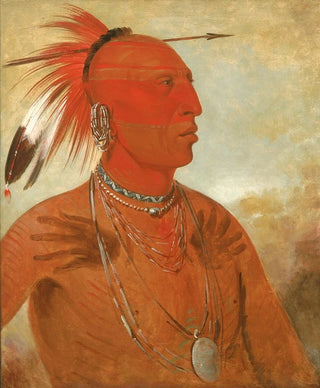Painting Lawhhecootslashwno Brave Chief and Skidi Wolf Pawnee - George Catlin


View from behind

Frame (optional)
In the fascinating world of art, some works transcend the mere frame to immerse us in a rich visual narrative full of history and culture. The Lawhhecootslashwno Brave Chief and Skidi Wolf Pawnee art print, created by George Catlin, is one of these iconic pieces. Through this painting, Catlin does not merely depict Native figures; he tells a story, that of the Pawnees, a people whose traditions and struggles are immortalized on canvas. This piece transports us to the heart of the American plains, where wild nature and tribal life intertwine in delicate harmony. Contemplating this art print, one can almost feel the breath of the wind and the heartbeat of a vibrant and resilient culture.
Style and uniqueness of the work
George Catlin's style is distinguished by his ability to capture not only the physical traits of his subjects but also the very essence of their existence. In Lawhhecootslashwno Brave Chief and Skidi Wolf, the meticulous details of traditional costumes, the dignified postures, and the deep expressions of the characters reveal a rare intimacy. Catlin uses a palette of earthy colors that evoke the natural landscape of the Great Plains, thus strengthening the connection between the characters and their environment. Symbolic elements, such as feathers and motifs, enrich the visual storytelling, offering us a glimpse into the beliefs and values of this culture. Every brushstroke seems to tell a story, every shadow and light emphasizing the depth of human experience. This painting is much more than a simple representation; it is a tribute to a threatened cultural identity, an invitation to celebrate the diversity of traditions.
The artist and his influence
George Catlin, pioneer of 19th-century American art, dedicated his life to immortalizing the indigenous peoples of North America. Traveling across the continent, he encountered and documented tribes whose ways of life were often threatened by colonial expansion. His artistic approach, blending realism and romanticism, helped give a visual voice to often little-known cultures. Catlin understood the importance of preserving these stories

Matte finish

View from behind

Frame (optional)
In the fascinating world of art, some works transcend the mere frame to immerse us in a rich visual narrative full of history and culture. The Lawhhecootslashwno Brave Chief and Skidi Wolf Pawnee art print, created by George Catlin, is one of these iconic pieces. Through this painting, Catlin does not merely depict Native figures; he tells a story, that of the Pawnees, a people whose traditions and struggles are immortalized on canvas. This piece transports us to the heart of the American plains, where wild nature and tribal life intertwine in delicate harmony. Contemplating this art print, one can almost feel the breath of the wind and the heartbeat of a vibrant and resilient culture.
Style and uniqueness of the work
George Catlin's style is distinguished by his ability to capture not only the physical traits of his subjects but also the very essence of their existence. In Lawhhecootslashwno Brave Chief and Skidi Wolf, the meticulous details of traditional costumes, the dignified postures, and the deep expressions of the characters reveal a rare intimacy. Catlin uses a palette of earthy colors that evoke the natural landscape of the Great Plains, thus strengthening the connection between the characters and their environment. Symbolic elements, such as feathers and motifs, enrich the visual storytelling, offering us a glimpse into the beliefs and values of this culture. Every brushstroke seems to tell a story, every shadow and light emphasizing the depth of human experience. This painting is much more than a simple representation; it is a tribute to a threatened cultural identity, an invitation to celebrate the diversity of traditions.
The artist and his influence
George Catlin, pioneer of 19th-century American art, dedicated his life to immortalizing the indigenous peoples of North America. Traveling across the continent, he encountered and documented tribes whose ways of life were often threatened by colonial expansion. His artistic approach, blending realism and romanticism, helped give a visual voice to often little-known cultures. Catlin understood the importance of preserving these stories
12,34 €






